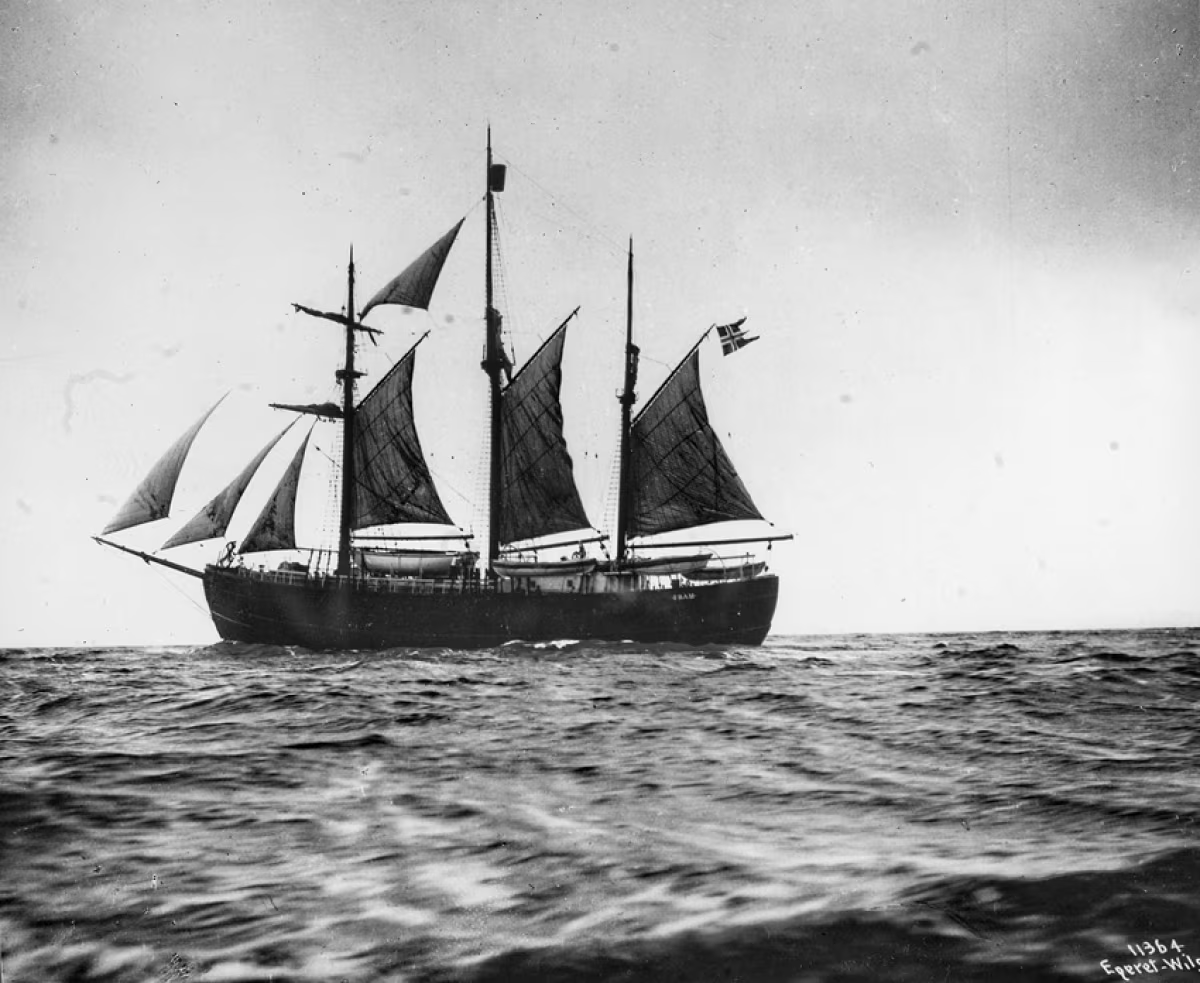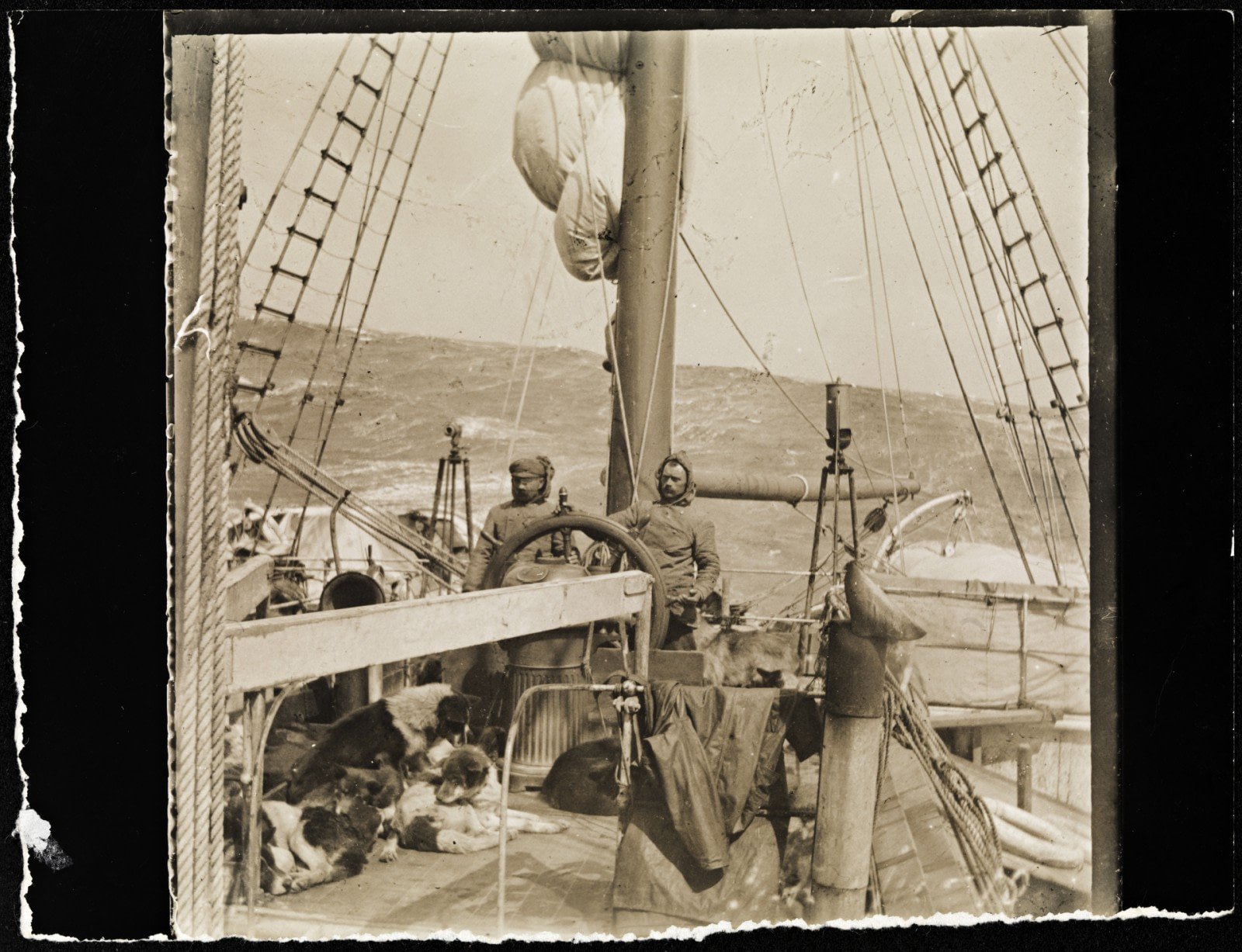The polar exploits of the legendary Roald Amundsen
Unlike Robert Falcon Scott, Roald Amundsen had been dedicated to exploration since the age of 15, when he read about Franklin's Arctic expeditions. Amundsen wrote,' the narrative that appealed to me most strongly was the suffering he and his men endured. A strange ambition burned within me to endure those same sufferings.' And so, he dedicated himself to becoming an Arctic explorer.
Amundsen attempts the Northwest Passage
In 1897, Amundsen secured a place on the Belgian Antarctic Expedition, Belgica, which endured disaster when scurvy affected the whole ship's company. Immediately, Amundsen took over command and, working with the renowned and controversial polar explorer Frederick Cook, ordered all the men to eat fresh, raw meat as a source of vitamin C. Upon returning to Europe in 1899, following a prolonged period of suffering and hardship trapped in the ice, Amundsen attempted the North-West Passage.
In 1903, instead of heading into the semi-permanent ice stream of Victoria Channel, Amundsen ventured around the sheltered eastern side of King William Island, becoming the first to navigate the entire North-West passage by ship. It was not until 1906 that Amundsen and his crew returned to Norway, having spent almost three and a half years abroad. Following this exploit, signaled as a great achievement for Norway, Amundsen then set his sights on being the first to reach the North Pole. However, as he had organized his ship, materials, and equipment, international headlines were filled with the news of Admiral Peary's successful expedition to the North Pole in April 1909. Amundsen wrote, "This was a blow indeed… If I was to maintain my prestige as an explorer, I must quickly achieve a sensational success of some sort… I resolved upon a coup".

The Fram under sail | © Riksarkivet (National Archives of Norway) via Flickr Commons
Roald Amundsen for the South Pole
With the North Pole seemingly conquered, Amundsen resolved to lead the first Antarctic expedition to reach the South Pole. With a telegram to Robert Falcon Scott, the famed British naval officer and explorer, who was himself in the midst of organizing the Terra Nova expedition of 1910-1913, informing him of his goal. With this, the race to the South Pole was on. Scott was lagging behind, with his expedition only able to start disembarking stores for the winter base at McMurdo Sound in January 1911. At Cape Evans, he was fifteen miles from his old winter quarters at Hut Points, which had iced up because, it is said, his Antarctic rival and peer Ernest Shackleton had left a window open.
A week later, Amundsen arrived in the Bay of Whales, sixty miles closer to the South Pole, and unloaded his dogs, sleds, and stores. Just like Peary, Amundsen used dog teams to haul his sleds. Following his experiences on the Belgica expedition, Amundsen was also keenly aware of the importance of fresh meat in his men's diets. So he came up with a brutal, but effective plan to use his dogs to both pull his sleds and as a steady supply of fresh meat when necessary, writing that he knew "the precise day on which I planned to kill each dog as its usefulness should end for drawing the diminishing supplies on the sleds and its usefulness should begin as food for the men".
In total, Amundsen's dog-led expedition was much larger than Scott's, with eight men and 118 dogs, while only 33 dogs and 17 ponies supported Scott's party of 33.
Scott loses the race
As they progressed across the ice in pursuit of their goal, Amundsen's party was covering four and a half miles an hour on skis and with light sleds, pulled by dogs, and powered ahead, leaving their final depot on 12 November. On 4 December, Amundsen's party slaughtered 40 dogs, and the weather began to worsen, with temperatures plummeting to -43° Celsius. The party preserved, and on 14 December, they raised the Norwegian flag on the South Pole.
Meanwhile, Scott and his party found themselves stuck at Beadmore Glacier, just off the Ross Ice Shelf. In quick succession, their ponies succumbed to the terrible polar conditions, having to slaughtered, while the motor sleds broke down. Undeterred, Scott and his companions pushed on, knowing they had to cover the 1,532 miles to the South Pole and back on foot over glaciers and up to over 10,000 feet before reaching the Polar Plateau.
Scott began his final push for the South Pole on 4 January, 178 miles from Three Degree Depot. On 18 January, they reached the South Pole only to find the Norwegian flag fluttering from an abandoned sled. Scott was bitterly disappointed, writing, "Great God! This is an awful place and terrible enough for us to have labored to it without the reward of priority."
On their journey home to Cape Evans, Scott and his party perished in circumstances written into polar legend. To a public aware that little support had been given to Scott, the almost noble and stoic defeat of his party on the quest to be the first to reach the South Pole seemed almost preferable to the victory of Amundsen. Amundsen visited England towards the end of 1912 and gave a lecture on his polar exploits , which Scott's wife, Kathleen, found "modest but excessively dull."
Amundsen continues his polar exploration
After the end of the First World War, Amundsen continued his polar exploration, recognizing the importance of the air in getting to remote places. This time, Amundsen set his sights on being the first to fly to the North Pole. With financial backing from the American explorer Lincoln Ellsworth, Amundsen received an Italian-built N-1 airship named Norge (Norway), captained by its Italian-designer pilot Umberto Nobile. Norge arrived in Spitzbergen, ready for Amundsen.
Meanwhile, famed explorer Commander Richard E. Byrd arrived with two airplanes, the aim being the first to fly to the North Pole. When there appeared to be no room for Byrd's ship to dock King's Bay alongside a ship occupied by the Amundsen/Nobile party, Byrd floated his aircraft ashore and lashed to a pontoon. Hearing that Byrd may get off the ground first, Nobile attempted to hasten preparations for a premature departure of Norge, but Amundsen refused to push off earlier than planned: An unplanned dash to the North Pole was not his style at 2 a.m. Byrd took off to return triumphant at 5 p.m. Amundsen declared that he was delighted for Byrd as flying over the North Pole was only one of two projects.
Amundsen’s wish granted
When Norge finally took off with Amundsen, Ellsworth, and Nobile, along with Nobile's little dog Titina, on 11 May, Amundsen and Ellsworth each brought along a tiny flag, no larger than a pocket handkerchief, to drop over the North Pole. Nobile, however, determined to upstage both men, brought along armfuls of flags.
Amundsen wrote, "The Norge looked like a circus wagon of the skies." Nobile even produced one Italian flag so large he could hardly see out the window. When released, it clung to the front of Norge before drifting to the back, threatening to damage the propeller. At least five miles beyond the North Pole, Nobile's giant flag "fluttered free and sank swiftly to the surface of the ice below us."
Later, in 1928, Nobile faced trouble when the Italia crashed in the Arctic. Amundsen came out of retirement to volunteer to search for him.
Before doing so, Amundsen had written to his friend, "If you only knew how splendid it is up there! That's where I want to die; and I only wish that death will come to me chivalrously." Meanwhile, Amundsen took off from Tromsø for the first leg of the flight to Spitsbergen in a Latham seaplane to join the search for Nobile. In the meantime, Nobile was found and rescued. But of Amundsen, there was no sign. He vanished, and no trace could be found. Until that is, a pontoon from his plane was discovered floating in the sea off the Fugloe Islands ten weeks later. Amundsen's wish had been granted: He died in his plane while trying to save a life.

© National Library of Norway ("Fram" i høy sjø, 1910), via Wikimedia Commons

